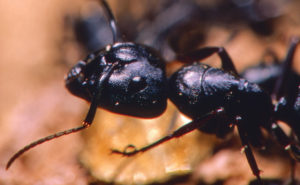
The black carpenter ant (Camponotus pennsylvanicus) is one of many pesky species that can inflict economic damage on an account. PHOTO: COURTESY OF, AND COPYRIGHTED BY, GENE WHITE, PMIMAGES@EARTHLINK.NET
Q: What’s the best way to proceed when a commercial client team tells you they have a difficult ant problem?
—ANTSY ABOUT ASSUAGING APPREHENSION
A: Ants can be frustrating for commercial clients and pest management professionals (PMPs) alike. Infestations can appear, become widespread quickly and may seemingly just disappear before the PMP arrives — only to appear somewhere else after the PMP leaves.
Ants are mostly a nuisance, but certain types can cause more serious problems or even prompt health code violations in some industries. Carpenter ants (Camponotus spp.) can damage property by chewing wood into sawdust as they excavate and build tunnels and galleries for their nests. Pharaoh ants (Monomorium pharaonis) can be particularly problematic in hospital settings, where they can contaminate wounds by spreading pathogenic bacteria.
Ants can contaminate and ruin food and other products. If seen by your client’s customers, they can give the impression that a facility is “unclean” — resulting in lost business and a bad public image. Yes, ants are mostly a nuisance, but often they are so much more.
Some ants bite, some sting. Some, like fire ants (Solenopsis spp.), can do both. With swift action, correct identification, proper treatment and a preventive plan in place, you can help clients solve stubborn ant infestations in commercial properties.
Focus on IPM
When it comes to deciding which treatment is best, the wide variety of dietary requirements and colony behavior make the answers so complex that they exceed the scope of this column. However, consistently following the basic principles of integrated pest management (IPM) will facilitate treatment success and client satisfaction:
1. Inspect and identify. With more than 700 ant species in the United States, identification can be challenging. While only 25 or so of those 700 traditionally are considered “pests,” the technician still is required to be well-informed and trained on the physical and behavioral characteristics of the different species. The size(s) of the ant, type(s) of food they’re consuming, nest type/location, trailing behavior, number of nodes, and determining whether the ants are active during daytime or nighttime hours can help pinpoint correct identification.
2. Determine your plan of attack. Knowing the species is critical in determining a treatment strategy, because some ants are most effectively eliminated using only gel or granular baits. Some are better controlled by including perimeter pesticide applications and wall-void treatments, whereas others only can be controlled by treating the colonies directly. A few species, like the pharaoh ant and the Argentine ant (Linepithema humile), can spread by “budding.” This occurs when groups of workers break off from the main colony with or without a mature queen. Treating budding ants improperly can cause the problem to get worse instead of better.
3. Implement physical, cultural and chemical controls as warranted. Work with your client to address environmental, structural and sanitation issues (see box, p. 52). Then responsibly apply pesticides as appropriate, given the ants and the setting(s) in question. As mentioned earlier, there are too many possibilities to make providing a list here an option, but resources like your company’s technical team, the Truman’s Scientific Guide to Pest Management Operations, manufacturer representatives, and local extension offices can provide product selection and application guidance.
4. Monitor your results. Last but not least, conduct follow-up inspections and reports to ensure your efforts have solved the problem. At commercial accounts, if you’re not vigilant, complacency can slide environmental controls back to where they were before. Also, caution your client against “being helpful” outside your recommendations: Using over-the-counter products, for example, usually won’t solve infestations, and can actually make the problem worse by causing colonies to bud, repelling ants into new areas, and/or interfering with baiting efforts.
Develop a preventive plan
An effective ant management strategy at a commercial account includes working with your client to develop a preventive plan to address sanitation and structural issues. Ants have a keen sense of smell, with odor receptors on their antennae that enable them to quickly find food sources. Suggest to your clients that they store food products in airtight containers, clean up all spills frequently, and remove garbage promptly. Ants leave behind a trail of pheromones, or chemical scents, which enable them and other ants to find their way to food sources and to return repeatedly. If it won’t interfere with your treatment plan, instruct clients to thoroughly clean any areas where ants have been trailing.
Also work with your clients to seal entry points. This can be quite challenging with many ant species. For example, the Argentine ant might be only 1/8 inch or so long, but it can fit easily through a hole that is only 1/16 inch wide or smaller. Knowing the foraging behavior of the ants and following their trails can help you locate entry points and facilitate the development of an exclusion plan.
Email your questions about insect identification and pest management technologies to pmpeditor@northcoastmedia.net. Your questions most likely will be printed and answered in one of Pest Management Professional’s upcoming columns.
Baldwin is director of technical, training and regulatory services for Terminix Commercial. He may be reached at dbaldwin@terminix.com.
The post Ask the Expert: Help customers help you in tough ant accounts appeared first on Pest Management Professional.
from Pest Management Professional https://www.mypmp.net/2020/04/10/ask-the-expert-help-customers-help-you-in-tough-ant-accounts/
Sacramento CA
No comments:
Post a Comment